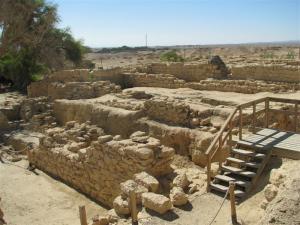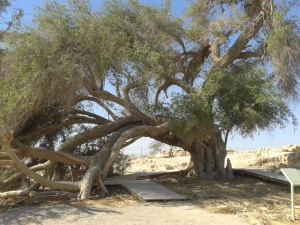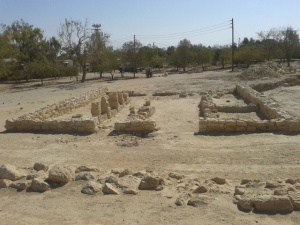
 At Ein Hazeva junction on Road 90, 20 km south of the Dead Sea and 150 km north of Eilat, sits a little-known site known alternatively by the names “Biblical Tamar” and “Ir Ovot”. Although, as we shall see, neither of these names may be accurate, the site is very interesting nonetheless. It is easily accessible to anyone traveling to Eilat on this road, and is worth visiting if you are ever in the area with a few minutes to spare (especially because there is no entrance fee required).
At Ein Hazeva junction on Road 90, 20 km south of the Dead Sea and 150 km north of Eilat, sits a little-known site known alternatively by the names “Biblical Tamar” and “Ir Ovot”. Although, as we shall see, neither of these names may be accurate, the site is very interesting nonetheless. It is easily accessible to anyone traveling to Eilat on this road, and is worth visiting if you are ever in the area with a few minutes to spare (especially because there is no entrance fee required).
Deep in the heart of the Arava region, we are currently in an area that was throughout history completely isolated and far from civilization. Nevertheless, there are some remains of small outposts here from different time periods, due to the proximity of the site to several major roads and the abundant Ein Husub spring that flowed here until recently (the spring has been largely dried up because of drilling for ground water to support local agriculture,

but the large jujube tree that still grows there is testimony to its existence).
Let’s go down into the archaeological site layer by layer. As we descend, we’ll be able to peel away thousands of years of history, and ultimately connect with a few of the key figures described in the Bible from the First Temple period.
We’ll start at the top. The first building we see here is a white modern structure, less than 100 years old. This was used during the British Mandate by the “Camel Police” who patrolled the desert. Twice each week, an officer stationed here would set out on a patrol on camelback, traveling south on the road until he met an officer he who made the journey north from Um Rashrash (today’s Eilat), and then return to his post. Apparently, even in the not-so-distant past, this site was very isolated!
As we descend into the older remains, we find remnants of settlement in the early Moslem period, a Nabatean outpost that formed one of the stations on the desert Spice Route, as well as some earlier Roman ones dating from the era of the Emperor Diocletian.
Beneath these ruins, excavators uncovered remains from at least two separate points during the First Temple period. It’s important to understand that the borders of Jewish settlement were usually much further north (the Biblical phrase “from Dan to Beer Sheva” comes to mind – Beer Sheva is over 50 km north of here), so if a Judean king established a fortress or outpost here, this means he was a powerful king who had both the interest and the ability to reach deep into the Negev desert towards the Red Sea port of Eilat.

The later remains at the site include this typical Israelite house, dated to the time of King Yoshiyahu. Fascinatingly, nearby there are remnants of an Edomite pagan temple. The idolatrous figurines that were found here (some of which are on display at the Israel Museum) show signs of deliberate destruction. This may well be physical evidence of Yoshiyahu’s heroic campaign to stamp out pagan worship from among the people, in his desperate attempt to prevent the approaching destruction predicted by the prophets (see II Melachim 23:4-15).
Beneath this layer there are even older remains, dated to either the time of King Amatzia, who fought a war against the Edomites who lived here (II Melachim 14:7), or King Uziyahu, who built a port city at Eilat (II Melachim 14:22).
Although no remains have yet been found here from his time, we know of an earlier king who also built a port at Eilat – none other than King Shlomo himself (I Melachim 9:26)! Some researchers believe that this site is the place called “Tamar Bamidbar” (literally, “a date-palm in the desert”) built by Shlomo (I Melachim 9:18). Others have suggested identifying this site as Ovot, one of the places that the Israelites camped in during their 40 years of wandering in the desert (Bamidbar 21:10, 33:43), although this association is problematic. If it is correct, though, then we are touching an even earlier period in our history, and that would mean Moshe Rabbenu himself was here.
There’s also one more time period associated with Jewish settlement in this area, and that is our own generation!
Today, although still somewhat remote, this region is far from deserted. The agricultural settlements of the Central Arava Regional Council, home to just over three thousand Jews, are in this immediate vicinity. These small settlements, whose exports provide Europe with substantial quantities of certain types of vegetables and make up 60% of Israel's total agricultural exports, represent one of the most amazing examples of Israelis “making the desert bloom”. The water for those settlements and farms comes from the same source as the Ein Husub spring that supplied the outposts here.
As in the times of the Bible, Jewish presence here deep in the desert is a sign of a particularly successful period of connection between Am Yisrael (the Nation of Israel) and Eretz Yisrael (the Land of Israel). Coming to this spot and learning a bit of Torat Yisrael connects us with our past and present, and helps us build our future.

Sign up for my newsletter for periodic articles along with updates on new talks, classes and videos, and upcoming speaking engagements and public tours